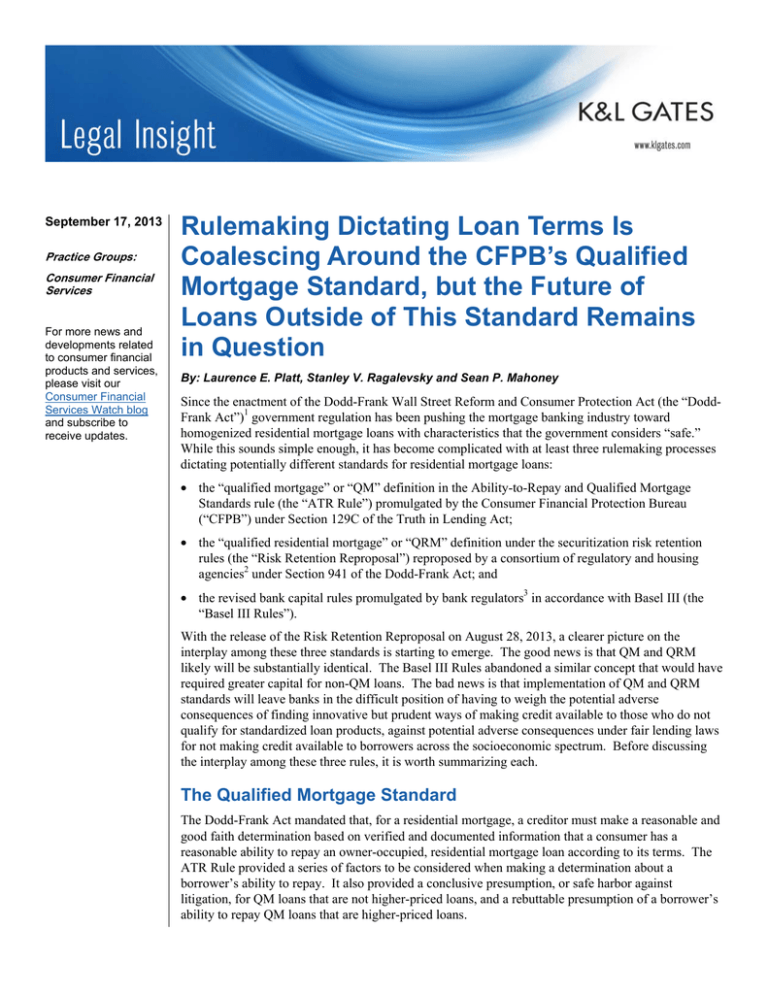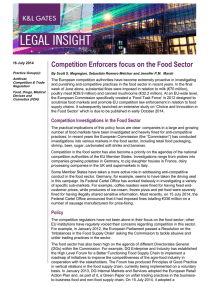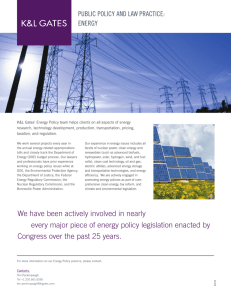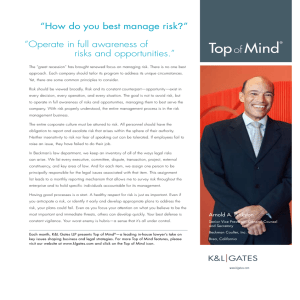
September 17, 2013
Practice Groups:
Consumer Financial
Services
For more news and
developments related
to consumer financial
products and services,
please visit our
Consumer Financial
Services Watch blog
and subscribe to
receive updates.
Rulemaking Dictating Loan Terms Is
Coalescing Around the CFPB’s Qualified
Mortgage Standard, but the Future of
Loans Outside of This Standard Remains
in Question
By: Laurence E. Platt, Stanley V. Ragalevsky and Sean P. Mahoney
Since the enactment of the Dodd-Frank Wall Street Reform and Consumer Protection Act (the “DoddFrank Act”)1 government regulation has been pushing the mortgage banking industry toward
homogenized residential mortgage loans with characteristics that the government considers “safe.”
While this sounds simple enough, it has become complicated with at least three rulemaking processes
dictating potentially different standards for residential mortgage loans:
• the “qualified mortgage” or “QM” definition in the Ability-to-Repay and Qualified Mortgage
Standards rule (the “ATR Rule”) promulgated by the Consumer Financial Protection Bureau
(“CFPB”) under Section 129C of the Truth in Lending Act;
• the “qualified residential mortgage” or “QRM” definition under the securitization risk retention
rules (the “Risk Retention Reproposal”) reproposed by a consortium of regulatory and housing
agencies2 under Section 941 of the Dodd-Frank Act; and
• the revised bank capital rules promulgated by bank regulators3 in accordance with Basel III (the
“Basel III Rules”).
With the release of the Risk Retention Reproposal on August 28, 2013, a clearer picture on the
interplay among these three standards is starting to emerge. The good news is that QM and QRM
likely will be substantially identical. The Basel III Rules abandoned a similar concept that would have
required greater capital for non-QM loans. The bad news is that implementation of QM and QRM
standards will leave banks in the difficult position of having to weigh the potential adverse
consequences of finding innovative but prudent ways of making credit available to those who do not
qualify for standardized loan products, against potential adverse consequences under fair lending laws
for not making credit available to borrowers across the socioeconomic spectrum. Before discussing
the interplay among these three rules, it is worth summarizing each.
The Qualified Mortgage Standard
The Dodd-Frank Act mandated that, for a residential mortgage, a creditor must make a reasonable and
good faith determination based on verified and documented information that a consumer has a
reasonable ability to repay an owner-occupied, residential mortgage loan according to its terms. The
ATR Rule provided a series of factors to be considered when making a determination about a
borrower’s ability to repay. It also provided a conclusive presumption, or safe harbor against
litigation, for QM loans that are not higher-priced loans, and a rebuttable presumption of a borrower’s
ability to repay QM loans that are higher-priced loans.
Rulemaking Dictating Loan Terms Is Coalescing Around
the CFPB’s Qualified Mortgage Standard, but the Future of
Loans Outside of This Standard Remains in Question
Broadly defined, a QM loan has the following requirements:
• no negative amortization
• no interest-only payments
• no balloon payments
• no terms in excess of thirty years
• verification and documentation of the borrower’s financial resources
• points and fees must be less than three percent of the principal amount of the loan (but certain bona
fide discount points excluded from this calculation in certain cases)
• monthly payments, for purposes of calculations used in determining QM status, based on the
highest payment in first five years
• total debt to income ratio cannot exceed 43%, except in the case of loans meeting certain
government affordability or other standards (e.g., loans meeting Fannie Mae or Freddie Mac
requirements, or loans that are eligible for government insurance or guarantees)
For a more detailed discussion of the ATR Rule, please see our alert entitled, “Was Chicken Little an
Optimist?” (May 23, 2013).
Qualified Residential Mortgage Loans
Section 941 of the Dodd-Frank Act directed the Agencies to adopt regulations requiring “securitizers”
to retain a portion of the risk associated with securitized assets. This has popularly been referred to as
a “skin in the game” requirement intended to align the interests of those originating or aggregating
loans, with the interests of investors in securitizations of those loans. The Dodd-Frank Act also
contemplated an exception from risk retention for “qualified residential mortgages.” The Agencies
first issued a proposed rulemaking under Section 941 of the Dodd-Frank Act on April 14, 2011 then
issued the Risk Retention Reproposal on August 20, 2013 rather than final rules.4
The definition of “qualified residential mortgage” under Section 941 of the Dodd-Frank Act can be no
broader than the definition of “qualified mortgage” under Section 129C of the Truth in Lending Act.
In order to simplify compliance, the Agencies now propose to define “qualified residential mortgage”
by cross-referencing to the definition of “qualified mortgage” under Section 129C of the Truth in
Lending Act and regulations promulgated thereunder. Excluded from “qualified residential
mortgage,” however, are loans that are either not subject to the ATR Rule or excluded from the
definition of QM, such as home equity lines of credit, loans secured by time shares, bridge loans with
a term of twelve (12) months or less, loan modifications (other than those included in 12 C.F.R. §
1026.20(a)), and loans made by community based programs, down-payment assistance providers,
certain non-profit organizations and housing agencies. Loans that qualify as QM loans under certain
small lender portfolio loan exemptions in the ATR Rule would also be excluded from “qualified
residential mortgage” to the extent that such loans must be held in portfolio for a period of time to
qualify as a QM loan.
The approach taken in the Risk Retention Reproposal has the advantage of ensuring that the terms
“qualified residential mortgage” and “qualified mortgage” generally would always be aligned,
avoiding the possibility of a change in one definition without a change in the other. While the point
2
Rulemaking Dictating Loan Terms Is Coalescing Around
the CFPB’s Qualified Mortgage Standard, but the Future of
Loans Outside of This Standard Remains in Question
has been made that the two terms serve different purposes – one is to protect investors in structured
products while the other is to protect borrowers – these purposes are served with a common strategy of
ensuring that loans are properly underwritten and that borrowers have the wherewithal to repay.
The Risk Retention Reproposal would impose potential put-back obligations on the person who
organizes or initiates a securitization of QRM loans (i.e., the sponsor), even though the sponsor would
not otherwise be required to retain risk. If a non-QRM loan is inadvertently placed in the pool, the
sponsor would be required to repurchase such loan within sixty (60) days of discovery of the related
facts. In addition, the person that aggregates and then transfers or sells QRM loans to a securitization
vehicle (i.e., the depositor)5 would be required to certify that it evaluated the effectiveness of its
internal controls related to loan selection used to ensure the qualification of QRM loans. This
approach addresses compliance with the QRM exception, and also provides a cure mechanism for
those situations in which non-QRM loans are included in a QRM securitization pool.
The Risk Retention Reproposal also requests comment on a “QM-plus” concept which would define
“qualified residential mortgage” as a “qualified mortgage” but also include an added requirement that
the loan have a loan-to-value ratio of less than seventy percent (70%). In addition, a QM-plus loan
would need to be secured by a first lien mortgage on a one-to-four family dwelling that serves as the
primary residence of the borrower. Purchase money loans where there is more than one lien created in
the transaction (e.g., “piggy-back” loans) would not qualify as QM-plus loans. Credit history would
be taken into account and a loan would not be a QM-plus loan if the borrower: (a) is more than thirty
(30) days past due on any obligation at the time of a cut-off date; (b) had been more than sixty (60)
days past due on any obligation during the twenty-four (24) month period prior to a cut-off date; or (c)
had been a debtor in a bankruptcy proceeding, had suffered a judgment to collect a debt, had personal
property repossessed, had a one-to-four family property foreclosed upon or engaged in a short sale or
deed in lieu of foreclosure during the thirty-six (36) month period prior to a cut-off date.
For non-QRM loans, a sponsor or depositor of a securitization will be required to retain a five percent
(5%) exposure to the securitization through a “horizontal slice” (i.e., a first loss position), a “vertical
slice” (i.e., a proportional exposure to each of the tranches of the securitization), or any combination
of the two. The Risk Retention Reproposal also allows for reduced risk retention for securitizations
consisting of blended pools of QRM loans and non-QRM loans. Importantly, risk retention cannot be
pushed to an originator, unless an originator originates twenty percent (20%) or more of the unpaid
principal balance of loans in the securitization and certain other conditions are met. The retained risk
exposure could not be transferred or hedged for seven (7) years (or five (5) years if the aggregate
outstanding principal balance of the securitization is reduced to twenty-five percent (25%) of the
original aggregate principal balance). In a similar vein, risk retention is not required for
securitizations consisting entirely of seasoned residential loans that have been outstanding for more
than seven (7) years (or five (5) years if the aggregate outstanding principal balance is twenty-five
percent (25%) or less of the original aggregate principal balance).
Treatment of Residential Mortgage Loans under Basel III
Capital Rules
The final Basel III Rules were adopted by the United States bank regulators in July 2013. These rules
retain the current risk weights for mortgage loans in the standardized approach, abandoning a
3
Rulemaking Dictating Loan Terms Is Coalescing Around
the CFPB’s Qualified Mortgage Standard, but the Future of
Loans Outside of This Standard Remains in Question
complicated formula that was originally proposed. Given the interagency nature of the rulemaking,
the rules apply to all FDIC-insured institutions in the United States, as well as bank holding
companies (other than small bank holding companies) and all thrift holding companies.
Regulatory capital requirements are designed to ensure that banks retain a sufficient cushion to absorb
losses during times of economic stress. Capital adequacy is measured utilizing both risk weighted
measures and a leverage measure. Risk-weighted measures consist of a ratio of capital components
(i.e., tier 1 capital, tier 2 capital, etc.) to risk-weighted assets. Low risk assets such as government
securities generally require little or no capital cushion, but assets that present greater risk require a
larger capital cushion. The risk weighting of assets is the mechanism by which regulators both
determine the amount of capital required for specific types of assets and indirectly influence the type
of activities in which banks elect to engage.
Since the implementation of the Basel II Capital Accord in 2006, two sets of risk-based capital rules
have effectively governed the U.S. banking industry: the standardized approach and advanced
approaches. The standardized approach is used by most banks with risk-based capital ratios
determined by assigning risk weights for assets based upon regulatory criteria. Banks with more than
$250 billion in assets, however, are permitted to use advanced approaches, which measure risk-based
capital using regulatory formulas that incorporate inputs determined in accordance with a bank’s
internal ratings-based system. As mandated by the Dodd-Frank Act, banks that utilize advanced
approaches will also be subject to the standardized approach insofar as the standardized approach will
set the floor on the total amount of capital required at such banks.
One of the more controversial aspects of the capital rules proposed by bank regulators in 2012 was the
capital treatment of residential mortgage loan exposures. The bank regulators had proposed a matrix
with risk weights for residential mortgage loan exposures that increased with loan-to-value ratios, and
doubled or almost tripled based upon whether the loan did or did not have characteristics similar to
those included in QM and QRM. Thus, under the proposal, banks would have been required to hold
materially greater capital for loans that did not qualify for QM or QRM treatment, thereby creating
disincentives to lend outside of the narrow QM/QRM box. This approach has been abandoned.
The Basel III Rules retain the current fifty percent (50%) risk weighting for first-lien residential
mortgage loans, and a one hundred percent (100%) risk weighting for all other residential mortgage
loans under the standardized approach. To qualify for the fifty percent (50%) risk weighting, a loan
may not be more than ninety (90) days past due, may not be restructured or modified, and must be
underwritten in accordance with prudent underwriting standards established by the bank regulators
that specify, among other things, loan-to-value ratios. For purposes of determining risk weighting,
loans that are modified pursuant to the HAMP are not considered restructured or modified. Where the
same lender holds both a first-priority lien and junior liens with no intervening liens, the lender must
treat the senior and junior loans as a single credit exposure.
The Basel III Rules also retain the current capital treatment of mortgage loans insured or guaranteed
by the U.S. government or an agency of the U.S. government. Loans that are unconditionally
guaranteed would retain a risk weighting of zero, while loans that are conditionally guaranteed will
retain a risk weighting of twenty percent (20%).
The Basel III Rules change the treatment of securitization exposures, but structures are treated as
securitizations only when there are multiple tranches. For large institutions that are subject to the
market risk rule, the supervisory formula approach or simplified supervisory formula approach is
used. For all other institutions, a gross-up approach is applied using the following four parameters:
4
Rulemaking Dictating Loan Terms Is Coalescing Around
the CFPB’s Qualified Mortgage Standard, but the Future of
Loans Outside of This Standard Remains in Question
the pro rata share, the exposure amount, the enhanced amount, and the weighted average risk
weighting of the underlying assets.
The maximum risk weighting for a securitization exposure is 1250%, which is tantamount to a
deduction from capital. A first-loss position held as retained risk would likely equal or approach this
maximum. Thus, for a securitization consisting entirely of mortgages that would qualify for the 50%
risk weighting, a securitization with retained risk could actually require greater amounts of capital
than if the whole loans were held in portfolio. By way of example, if a bank held $100 in first-lien
residential mortgage loans with a risk weighting of 50%, it would need to hold $4 in capital to
maintain a risk-weighted capital ratio of 8% (50% x $100 x 8%). If those same loans were securitized
and the bank held a horizontal slice of 5%, in a first loss position at a risk weighting of 1250%, the
bank would need to hold $5 in capital (5% x $100 x 1250% x 8%).6 To state the obvious, the
interplay between the Basel III Rules and the form of risk retention (whether imposed by the market or
regulations promulgated under Section 941 of the Dodd-Frank Act) will need to be taken into account
in securitizations.
While the capital rules will not change the treatment of loans held in portfolio, they may make
securitizations of non-QRM loans more capital intensive when risk is retained as a horizontal slice.
The proposed rules had raised the possibility that portfolio lending would become more capital
intensive and that banks would need to develop new systems to track additional mortgage loan data
points in order to calculate capital requirements. Retaining the current risk weighting of residential
mortgage loans will not ameliorate the impact of QM or QRM, but we suspect that portfolio lenders
will appreciate that the Basel III Rules do not create an additional impediment to portfolio lending.
Witches’ Brew of Regulatory Impacts for Non-QM Loans
While lenders can take some comfort in the consistency between QM and QRM, it is anyone’s guess
as to what non-QM/non-QRM lending will look like as lenders will need to consider the impact of
ability-to-repay and risk retention in lieu of taking advantage of safe harbors and exemptions.
In the ATR Rule, the CFPB has provided guidance as to what a lender should consider in determining
the borrower’s ability to repay. But without the safe harbor, the lender bears the burden of proving
that the borrower had the ability to repay the loan, potentially for the life of the loan. For higherpriced QM loans, for which only a rebuttable presumption of ability to repay is available, lenders will
bear the same risk of having to prove the borrower’s ability to repay at some point in the future. This
risk alone may quiet the secondary market for non-QM loans and higher-priced QM loans.
Risk retention requirements may also remove motivation to securitize non-QRM loans as the capital
required to be held against a retained piece may be greater in many cases than the capital that would
be required to be held against those loans if held in portfolio. It remains to be seen whether a vibrant
private securitization market in non-QM/non-QRM loans will develop in the midst of these challenges
as well as uncertainty surrounding government sponsored entity reform.
One distinct possibility is that the market will coalesce around QM and QRM loans, with a very
limited volume of loans falling outside the QM criteria. This will make it increasingly difficult for
banks to be able to lend to borrowers who cannot meet the criteria, creating yet new challenges for fair
lending compliance.
5
Rulemaking Dictating Loan Terms Is Coalescing Around
the CFPB’s Qualified Mortgage Standard, but the Future of
Loans Outside of This Standard Remains in Question
Authors:
Laurence E. Platt
larry.platt@klgates.com
+1. 202.778.9034
Stanley V. Ragalevsky
stan.ragalevsky@klgates.com
+1.617.951.9203
Sean P. Mahoney
sean.mahoney@klgates.com
+1.617.261.3202
1
Pub. L. No. 111-203, 124 Stat. 1376 (2010).
The agencies involved (the “Agencies”) are: the Board of Governors of the Federal Reserve
System (the “FRB”), the Federal Deposit Insurance Corporation (the “FDIC”), the Office of the
Comptroller of the Currency (the “OCC”), the Securities and Exchange Commission (the “SEC”),
the U.S. Department of Housing and Urban Development (“HUD”) and the Federal Housing
Finance Agency (“FHFA”). HUD and FHFA participated in the rulemaking only with respect to
provisions governing residential mortgage loan securitizations.
3
The bank regulators involved are the FRB, FDIC and the OCC.
4
As a proposed regulation, the Agencies are soliciting comment on the Risk Retention
Reproposal.
5
If there is no such person, the sponsor of the securitization is deemed to be the depositor.
6
For residential mortgage loans with a 100% risk weighting, or in circumstances in which risk is
retained through a vertical slice or combination of horizontal and vertical slice, the capital held
against retained risk exposure may be less than the capital that would be required to be held
against the whole loans.
2
6
Consumer Financial Services Practice Contact List
K&L Gates’ Consumer Financial Services practice provides a comprehensive range of transactional,
regulatory compliance, enforcement and litigation services to the lending and settlement service
industry. Our focus includes first- and subordinate-lien, open- and closed-end residential mortgage
loans, as well as multi-family and commercial mortgage loans. We also advise clients on direct and
indirect automobile, and manufactured housing finance relationships. In addition, we handle
unsecured consumer and commercial lending. In all areas, our practice includes traditional and ecommerce applications of current law governing the fields of mortgage banking and consumer
finance.
For more information, please contact one of the professionals listed below.
LAWYERS
Boston
R. Bruce Allensworth
Irene C. Freidel
Stanley V. Ragalevsky
Brian M. Forbes
Andrew Glass
Sean P. Mahoney
Phoebe Winder
Gregory N. Blase
Ryan M. Tosi
Charlotte
John H. Culver III
Amy Pritchard Williams
Chicago
Michael J. Hayes Sr.
Dallas
David Monteiro
Miami
Paul F. Hancock
New York
Elwood F. Collins
Steve H. Epstein
Drew A. Malakoff
Pittsburgh
Melissa J. Tea
San Francisco
Jonathan Jaffe
Amanda D. Gossai
Seattle
Holly K. Towle
Sydney
Andrea P. Beatty
Daad Soufi
Abhishek Bansal
Jason Vongratsavi
Washington, D.C.
Costas A. Avrakotos
bruce.allensworth@klgates.com
irene.freidel@klgates.com
stan.ragalevsky@klgates.com
brian.forbes@klgates.com
andrew.glass@klgates.com
sean.mahoney@klgates.com
phoebe.winder@klgates.com
gregory.blase@klgates.com
ryan.tosi@klgates.com
+1.617.261.3119
+1.617.951.9154
+1.617.951.9203
+1.617.261.3152
+1.617.261.3107
+1.617.261.3202
+1.617.261.3196
+1.617.951.9059
+1.617.261.3257
john.culver@klgates.com
amy.williams@klgates.com
+1.704.331.7453
+1.704.331.7429
michael.hayes@klgates.com
+1.312.807.4201
david.monteiro@klgates.com
+1.214.939.5462
paul.hancock@klgates.com
+1.305.539.3378
elwood.collins@klgates.com
steve.epstein@klgates.com
drew.malakoff@klgates.com
+1.212.536.4005
+1.212.536.4830
+1.216.536.4034
melissa.tea@klgates.com
+1.412.355.8385
jonathan.jaffe@klgates.com
amanda.gossai@klgates.com
+1.415.249.1023
+1.415.882.8020
holly.towle@klgates.com
+1.206.370.8334
andrea.beatty@klgates.com
daad.soufi@klgates.com
abhishek.bansal@klgates.com
jason.vongratsavi@klgates.com
+61.2.9513.2333
+61.2.9513.2300
+61.2.9513.2300
+61.2.9513.2300
costas.avrakotos@klgates.com
+1.202.778.9075
7
Consumer Financial Services Practice Contact List
David L. Beam
Holly Spencer Bunting
Melanie Brody
Krista Cooley
Daniel F. C. Crowley
Eric J. Edwardson
Steven M. Kaplan
Phillip John Kardis II
Rebecca H. Laird
Michael J. Missal
Laurence E. Platt
Stephanie C. Robinson
Phillip L. Schulman
David Tallman
Stephen G. Topetzes
Nanci L. Weissgold
Kris D. Kully
Emily J. Booth
Morey E. Barnes Yost
Kathryn M. Baugher
Andrew L. Caplan
Soyong Cho
Shanda N. Hastings
Anaxet Y. Jones
Rebecca Lobenherz
Eric Mitzenmacher
Tori K. Shinohara
Kerri M. Smith
Kathryn S. Williams
david.beam@klgates.com
holly.bunting@klgates.com
melanie.brody@klgates.com
krista.cooley@klgates.com
dan.crowley@klgates.com
eric.edwardson@klgates.com
steven.kaplan@klgates.com
phillip.kardis@klgates.com
rebecca.laird@klgates.com
michael.missal@klgates.com
larry.platt@klgates.com
stephanie.robinson@klgates.com
phil.schulman@klgates.com
david.tallman@klgates.com
stephen.topetzes@klgates.com
nanci.weissgold@klgates.com
kris.kully@klgates.com
emily.booth@klgates.com
morey.barnesyost@klgates.com
kathryn.baugher@klgates.com
andrew.caplan@klgates.com
soyong.cho@klgates.com
shanda.hastings@klgates.com
anaxet.jones@klgates.com
becky.lobenherz@klgates.com
eric.mitzenmacher@klgates.com
tori.shinohara@klgates.com
kerri.smith@klgates.com
kathryn.williams@klgates.com
+1.202.778.9026
+1.202.778.9853
+1.202.778.9203
+1.202.778.9257
+1.202.778.9447
+1.202.778.9387
+1.202.778.9204
+1.202.778.9401
+1.202.778.9038
+1.202.778.9302
+1.202.778.9034
+1.202.778.9856
+1.202.778.9027
+1.202.778.9046
+1.202.778.9328
+1.202.778.9314
+1.202.778.9301
+1.202.778.9112
+1.202.778.9215
+1.202.778.9435
+1.202.778.9094
+1.202.778.9181
+1.202.778.9119
+1.202.778.9414
+1.202.778.9177
+1.202.778.9127
+1.202.778.9423
+1.202.778.9445
+1.202.778.9122
PROFESSIONALS
Government Affairs Advisor / Director of Licensing
Washington, D.C.
Stacey L. Riggin
stacey.riggin@klgates.com
+1.202.778.9202
Regulatory Compliance Analysts
Washington, D.C.
Dameian L. Buncum
Teresa Diaz
Robin L. Gieseke
Brenda R. Kittrell
Dana L. Lopez
Patricia E. Mesa
Daniel B. Pearson
Jeffrey Prost
+1.202.778.9093
+1.202.778.9852
+1.202.778.9481
+1.202.778.9049
+1.202.778.9383
+1.202.778.9199
+1.202.778.9881
+1.202.778.9364
dameian.buncum@klgates.com
teresa.diaz@klgates.com
robin.gieseke@klgates.com
brenda.kittrell@klgates.com
dana.lopez@klgates.com
patty.mesa@klgates.com
daniel.pearson@klgates.com
jeffrey.prost@klgates.com
8
Consumer Financial Services Practice Contact List
Anchorage Austin Beijing Berlin Boston Brisbane Brussels Charleston Charlotte Chicago Dallas Doha Dubai Fort Worth Frankfurt
Harrisburg Hong Kong Houston London Los Angeles Melbourne Miami Milan Moscow Newark New York Orange County Palo Alto Paris
Perth Pittsburgh Portland Raleigh Research Triangle Park San Diego San Francisco São Paulo Seattle Seoul Shanghai Singapore Spokane
Sydney Taipei Tokyo Warsaw Washington, D.C. Wilmington
K&L Gates practices out of 48 fully integrated offices located in the United States, Asia, Australia, Europe, the
Middle East and South America and represents leading global corporations, growth and middle-market companies,
capital markets participants and entrepreneurs in every major industry group as well as public sector entities,
educational institutions, philanthropic organizations and individuals. For more information about K&L Gates or its
locations, practices and registrations, visit www.klgates.com.
This publication is for informational purposes and does not contain or convey legal advice. The information herein should not be used or relied upon in
regard to any particular facts or circumstances without first consulting a lawyer.
©2013 K&L Gates LLP. All Rights Reserved.
9




